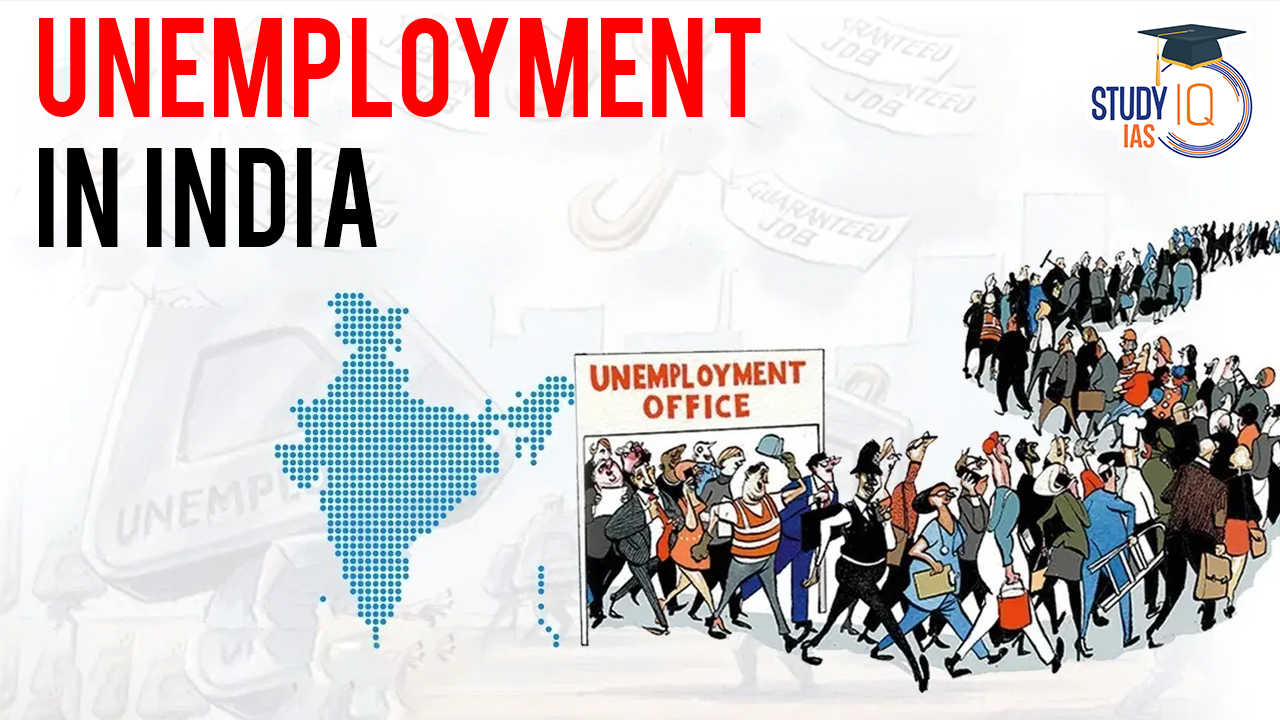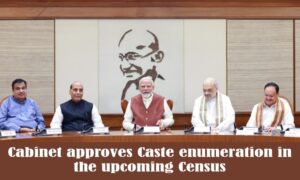Table of Contents
Context: India’s overall unemployment rate fell in July as rural areas saw increased demand for agriculture labor with the onset of monsoon rains.
What is Unemployment?
- Unemployment is a situation when a person actively searches for a job and is unable to find work. Unemployment indicates the health of the economy.
- Unemployment, according to the OECD, is people above a specified age not being in paid employment or self-employment but currently available for work during the reference period.
- An unemployed person as defined by the ILO is a person aged 15 or over who simultaneously meets three conditions:
- being unemployed for a given week;
- being available to take a job within two weeks;
- having actively sought a job in the last four weeks or
- having found one starting in less than three months.

Types of Unemployment
- Seasonal Unemployment: It is associated with certain industries that experience predictable fluctuations in labor demand throughout the year.
- For example, agricultural workers may be unemployed during the off-season, and retail workers hired for holiday shopping may become unemployed after the holidays.
- Disguised Unemployment: Disguised unemployment occurs when more people are engaged in a particular activity or job than is necessary for efficient production.
- This can be seen in sectors with low productivity, such as subsistence farming, where too many people work on a small plot of land, even though fewer workers could achieve the same output.
- Structural Unemployment: It arises from a mismatch between the skills, location, or qualifications of job seekers and the available job opportunities.
- This type of unemployment can be more persistent and is often caused by factors such as technological changes, shifts in the economy, or changes in consumer preferences.
- Frictional Unemployment: It is also called as Search Unemployment, refers to the time lag between the jobs when an individual is searching for a new job or is switching between the jobs.
- Frictional unemployment is a natural economic occurrence that happens when the economy is usually doing well.
- Cyclical Unemployment: It is closely tied to the business cycle and economic downturns.
- It occurs when there is a decrease in overall economic activity, leading to lower demand for labor.
- Technological Unemployment: It refers to the displacement of human workers by technological advancements and automation.
- Technological unemployment is a significant concern in the modern era as technology continues to advance rapidly.
Measurement of Unemployment
- The unemployment rate is the most frequent measure of unemployment.
- The unemployment rate is the number of people unemployed divided by the working population or people working under labour force.
- Unemployment rate = (Unemployed Workers / Total labour force) × 100.
- National Sample Survey Organization (NSSO) defines employment and unemployment on the following activity statuses of an individual.
- Daily Status Approach: unemployment status of a person under this approach is measured for each day in a reference week. A person having no gainful work even for one hour in a day is described as unemployed for that day.
- Weekly Status Approach: This approach highlights the record of those persons who did not have gainful work or were unemployed even for an hour on any day of the week preceding the date of the survey.
- Usual Status Approach: This gives the estimates of those persons who were unemployed or had no gainful work for a major time during the 365 days.
Key Highlights of the Periodic Labour Force Survey 2020-21
- Unemployment Rate: The unemployment rate in the country fell to 4.2% in 2020-21, compared with 4.8% in 2019-20.
- The rural areas recorded an unemployment rate of 3.3% and urban areas recorded an unemployment rate of 6.7%.
- Labour Force Participation Rate (LFPR): The percentage of persons in the labour force (that is, working or seeking work or available for work) in the population increased from 40.1% in the previous year to 41.6% during 2020-21.
- Worker Population Ratio (WPR): It increased from 38.2% of the previous year to 39.8%.
- WPR is defined as the percentage of employed persons in the population.
- Migration Rate: The migration rate is 28.9%. The migration rate among women was 48% and 47.8% in rural and urban areas, respectively.
About Periodic Labour Force Survey (PLFS)
- The National Statistical Office (NSO) launched the Periodic Labour Force Survey (PLFS) in April 2017.
- The objective of PLFS is to estimate the key employment and unemployment indicators (viz. Worker Population Ratio, Labour Force Participation Rate, Unemployment Rate).
Major Causes of Unemployment in India
- Large Population: The number of job seekers often exceeds the available job opportunities.
- Inadequate Economic Growth: Slow economic growth relative to the population growth rate means that the economy cannot create enough jobs to absorb the increasing workforce.
- Lack of Vocational Skills and Education: Many job seekers in India lack the necessary vocational skills or have low educational qualifications, making them less competitive in the job market.
- Nearly 93% of the population in India did not receive any vocational or technical training, according to Periodic Labour Force Survey (PLFS) 2017-18.
- Lack of employability: According to India Skills Report (ISR), less than half of the Indian graduates are employable. In 2021, as many as 45.9 per cent of graduates are employable, a decline from 46.21 per cent in 2020 and 47.38 per cent in 2010.
- Inadequate attention to small and medium enterprises (SMEs): SMEs are more labor intensive than that of large firms. However, big companies remain the main beneficiaries of the fiscal policy of the government.
- Agriculture as a Seasonal Occupation: Agriculture, which still employs a significant portion of the workforce, provides seasonal employment. Farmers and agricultural laborers often face unemployment during non-harvest seasons.
- Ineffective Economic Planning: A lack of comprehensive economic planning and policy measures to address the gap between labor supply and demand can result in unemployment.

- Decline in manufacturing jobs: Automation and multi-skilling has reduced the need for human resources.
- By 2030, up to 12 million women in India could risk losing their jobs to automation, according to a study by the McKinsey Global Institute.
- Social Factors:
- Labor Immobility: Cultural and social factors, such as strong family ties and linguistic or regional preferences, can limit labor mobility. Many people prefer to work close to their families, which can lead to unemployment in areas with limited job opportunities.
- Caste System: In some regions, the caste system restricts certain types of work to specific castes, limiting job opportunities for those not belonging to the favored community.
- Gender Norms: Regressive social norms and gender-based discrimination can deter women from entering or continuing employment, contributing to gender-specific unemployment.
Government Initiative to Tackle Unemployment
- MNREGA: Mahatma Gandhi National Rural Employment Guarantee Act launched in 2005 providing the right to work to people.
- It aimed to provide social security by guaranteeing a minimum of 100 days paid work per year to all the families whose adult members opt for unskilled labour-intensive work.
- Aajeevika – National Rural Livelihoods Mission (NRLM): It was launched by the Ministry of Rural Development (MoRD), Government of India in June 2011.
- The Mission aims at creating efficient and effective institutional platforms for the rural poor, enabling them to increase household income through sustainable livelihood enhancements and improved access to financial services.
- National Skill Development Mission: It was set up in November 2014 to drive the ‘Skill India’ agenda in a ‘Mission Mode’ in order to converge the existing skill training initiatives and combine scale and quality of skilling efforts, with speed.
- PMKVY: Pradhan Mantri Kaushal Vikas Yojana was launched in 2015. The objective of PMKVY was to enable the youth of the country to take up industry-relevant skill training in order to acquire a secured better livelihood.
- Start-Up India Scheme: The government launched the Start-Up India Scheme in 2016. The aim of Startup India programmes was to develop an ecosystem that nurtures and promotes entrepreneurship across the nation.
- Atma Nirbhar Bharat Rojgar Yojana (ABRY): It was launched with effect from 1st October, 2020 as part of Atma Nirbhar Bharat package 3.0 to incentivize employers for creation of new employment along with social security benefits and restoration of loss of employment during Covid-19 pandemic.
- ‘PM-DAKSH’ (Pradhan Mantri Dakshta Aur Kushalta Sampann Hitgrahi) Yojana: It is being implemented from the year 2020-21. Under this, eligible target groups are provided with the skill development training programmes on Short Term Training Program; Up-Skilling/Reskilling; Entrepreneurship Development Programme, and Long-Term Training Programme.
- National Career Service (NCS) Project for transformation of the National Employment Service to provide a variety of career related services like job matching, career counselling, vocational guidance, information on skill development courses, apprenticeship, internships etc.
- Production-Linked Incentive (PLI) Scheme: Recently, Finance Minister has announced an outlay of INR 1.97 Lakh Crores for the PLI Schemes across 13 key sectors, to create national manufacturing champions and generate employment opportunities for the country’s youth.
Way Forward
- Need of a comprehensive national employment policy: National employment policies seek to explicitly link growth and economic strategies to employment creation and diagnose the challenges and opportunities for productive job creation.
- Transformation of rural economy: Economic returns from States initiatives in transforming the rural economy from traditional agriculture to more value-added activities like horticulture has been demonstrated well in states such as Maharashtra and Himachal Pradesh.
- Recommendations of Standing Committee on Labour (2021 report):
- The Committee recommended central and state governments to:
- Encourage entrepreneurial opportunities,
- Attract investment in traditional manufacturing sectors and developing industrial clusters,
- Strengthen social security measures,
- Maintain a database of workers in the informal sector, and
- Promote vocational training.
- To increase women participation, it recommended:
- Increasing government procurement from women-led enterprises,
- Training women in new technologies,
- Providing women with access to capital, and
- Investing in childcare and linked infrastructure.
- The Committee recommended central and state governments to:


 Cabinet Approves Caste Enumeration in th...
Cabinet Approves Caste Enumeration in th...
 International Labour Day 2025, Theme, Hi...
International Labour Day 2025, Theme, Hi...
 India-Canada Relations, Evolution, Recen...
India-Canada Relations, Evolution, Recen...





















